Introduction
What Do Rabbits Nests Look Like: In the enchanting realm of wildlife, where nature weaves intricate tales of survival, the creation of nests stands as a testament to a species’ ingenuity and adaptability. Rabbit nests, concealed in the heart of meadows, fields, and forests, are no exception. These hidden sanctuaries serve as cradles for the next generation of these charming creatures. In this exploration, we venture into the realm of rabbit nests, unveiling the fascinating structures that shelter the tiniest lives in the animal kingdom.
Rabbit nests are typically situated in well-hidden spots that provide shelter from predators and the elements. They can be found beneath shrubs, tall grasses, or even in burrows if the mother rabbit has access to one.The primary material used in building rabbit shed is the surrounding vegetation. A doe carefully gathers grasses, leaves, and fur from her own body to create a soft and insulating lining for the nest.
Rabbit nests often resemble shallow depressions in the ground, lined with the collected materials. They are concave in shape, allowing the kits to be cradled within while remaining shielded from view.The nests are designed to blend seamlessly into their surroundings. The doe’s choice of location and her careful arrangement of materials ensure that the nest remains inconspicuous, reducing the risk of detection by predators.Rabbit nests are temporary structures meant to shelter kits during their most vulnerable stage of life. As the kits grow and become more independent, they will eventually leave the nest and venture into the world.
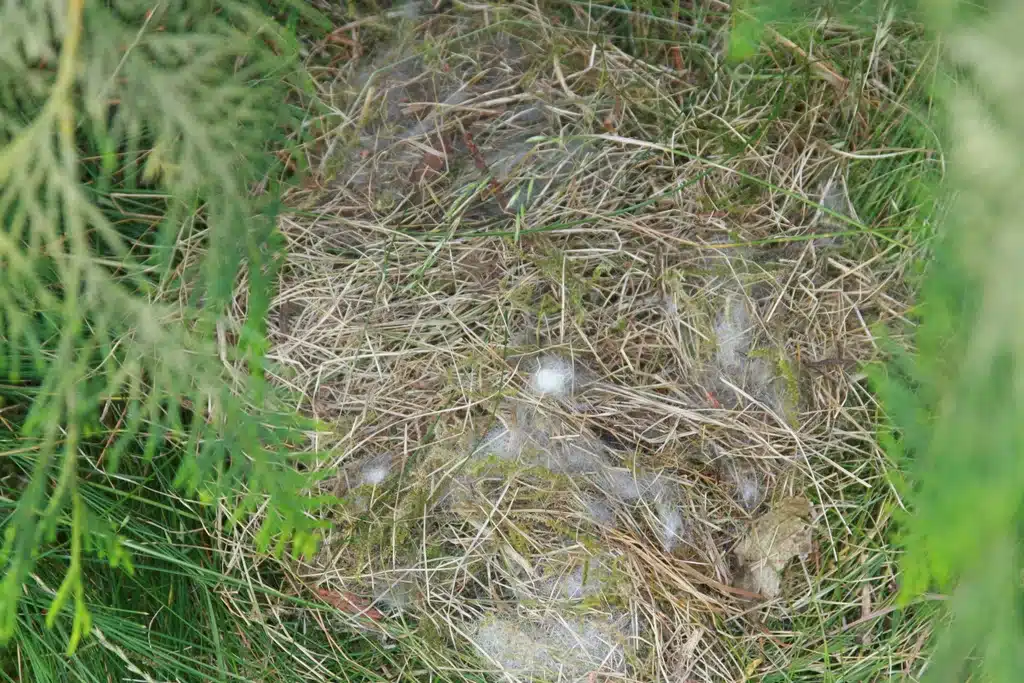
Where do rabbits make nests?
Cottontails commonly nest in backyards, parks, and other urban locations. Rabbit nests are typically a shallow depression in the ground covered with dried grass and tufts of fur, just enough to cover the babies and keep them warm.
Hidden Havens in Meadows and Fields
Rabbits are known for their preference for open spaces like meadows, fields, and grassy areas. In these expansive landscapes, they ingeniously construct their nests. Shallow depressions are formed within the grass, carefully lined with an array of natural materials collected from the surroundings. These grassy nests, concealed amidst the foliage, provide both camouflage and protection for the kits.
Beneath Shrubbery and Bushes
The edges of forests and shrubbery offer another preferred nesting spot for rabbits. Beneath the protective cover of low shrubs and bushes, they create cozy nests. The tangled branches and leaves serve as natural concealment, shielding the nests from the prying eyes of predators and human observers alike.
Underground Burrows
Certain species of rabbits, like the European rabbit, have evolved to utilize burrows as their nesting sites. These burrows offer an added layer of security for the vulnerable kits. The labyrinthine tunnels provide a complex network that not only shelters the young rabbits but also offers a means of escape from danger.
Natural Hollows and Cavities
In some cases, rabbits may take advantage of existing natural hollows, crevices, or cavities to create their nests. Such locations provide instant protection, as they are naturally concealed and can offer an immediate safe haven for the kits.
The Art of Camouflage
Regardless of the location, one common thread in all rabbit nests is their skillful camouflage. Whether nestled in grass, beneath shrubbery, or within burrows, the nests are designed to blend seamlessly into their surroundings. This natural camouflage minimizes the risk of detection by predators.
How deep is a rabbit nest?
Nests are dug in the ground and lined with grass and loose fur. Nests are relatively small, about 4″ across and 4″ deep. The female rabbit, or doe, typically has 2 or 3 litters per season with 3-8 rabbits per litter.
Camouflage and Safety
Regardless of the depth, one common factor in all rabbit nests is the need for camouflage and safety. Rabbits rely on their nesting skills to protect their young from predators and environmental elements. Camouflage and strategic placement are crucial elements in ensuring the survival of the kits.
Maternal Instincts
The depth of a rabbit nest is ultimately determined by the instincts of the mother rabbit. She assesses the environment and makes choices that will best protect her young. These choices include the type of nest to build, the location, and the depth.
Varying Depths for Different Species
The depth of a rabbit nest can vary based on the species of rabbit, the environment in which they live, and the specific nesting habits of the mother rabbit (doe). Different species of rabbits have evolved to adapt to various habitats, and this can influence the depth of their nests.
What do baby bunny holes look like?
Most dogs pull the fur out of the nest to get to the babies. The nest will look like a small softball-sized hole in the dirt, sometimes in the middle of the yard with nothing protecting it. Besides fur, there may be dried grass and leaves as bedding and over the top of the nest for camouflage.
Creating a Burrow
The construction of a baby bunny hole is a laborious process. Adult rabbits use their strong claws to dig into the soil, creating a network of tunnels and chambers. These burrows can extend horizontally and sometimes even vertically, providing a multi-layered home for the kits.
The Role of Maternal Instincts
Mother rabbits (does) play a crucial role in the creation and maintenance of baby bunny holes. They instinctively select secure and hidden locations to build these burrows, ensuring the safety and survival of their vulnerable offspring.
The Transition to Independence
As the kits grow and become more independent, they begin to venture out of the burrow to explore their surroundings and learn essential survival skills. The baby bunny hole serves as a starting point for their journey into the world.
A Window into Wildlife
Observing baby bunny holes from a distance provides a unique opportunity to witness the intricate balance of nature. It reminds us of the adaptability and resourcefulness of animals as they create safe havens for their young in the midst of a challenging environment.
What happens if you disturb a rabbit nest?
If you disturb a wild rabbit nest, you should not expect to see the mother rabbit around. To protect her babies, the mother stays away from the nest for most of the day. This keeps predators from following her or being attracted to her scent since baby rabbits are almost odorless.
Motherly Abandonment
One of the most significant outcomes of disturbing a rabbit nest is the potential abandonment by the mother rabbit, also known as a doe. Does are highly sensitive to human scents and the presence of foreign objects around the nest. If the nest is disturbed, the mother may perceive it as a threat and abandon her young to ensure her own safety.
Vulnerable Kits
Without the care and protection of the mother, the kits (young rabbits) become incredibly vulnerable. They rely on the warmth, nourishment, and guidance provided by their mother during their early stages of life. Abandonment leaves them exposed to predators, weather conditions, and a lack of nourishment.
Predator Attraction
Disturbing a rabbit nest can attract the attention of predators. The scent left behind by humans or the disturbance of the nest can alert predators to the presence of potential prey. This can lead to increased predation on both the vulnerable kits and the adult rabbits.
Environmental Impact
Rabbit nests are constructed with a delicate balance of materials that provide insulation, camouflage, and protection for the kits. Disrupting the nest can alter this balance and expose the kits to harsh weather conditions, affecting their chances of survival.
Stress and Trauma
Wild animals are highly sensitive to stress and trauma, and disturbances to their nests can induce significant stress responses. Stress can weaken the kits’ immune systems, making them more susceptible to illnesses and health issues.
How long do rabbits stay in nest?
Baby rabbits leave the nest when they’re 3 weeks old and about the size of a chipmunk. If you find a chipmunk-sized but fully-furred rabbit with eyes open, ears erect and the ability to hop, they are meant to be on their own. As small and helpless as they may look, they are not an orphan and don’t need your help.
The Nesting Period
The length of time that kits stay in their nests can vary based on several factors, including the species of rabbit, environmental conditions, and the individual development of the kits. On average, kits remain in their nests for approximately 10 to 21 days.
Growing Strong
During their time in the nest, kits undergo rapid growth and development. They rely on their mother’s milk for nourishment, and the mother (doe) visits the nest to nurse her young. The high-fat and nutrient-rich milk provides essential sustenance that fuels the kits’ growth.
Eyes Open to the World
Around the age of 10 to 14 days, kits begin to open their eyes, offering them their first glimpses of the world beyond their cozy chambers. As their senses awaken, they become more aware of their surroundings.
Exploring the Outside
As kits approach the age of 3 weeks, they become more active and curious. They may venture out of the nest, exploring their immediate surroundings under the watchful eye of their mother. This marks the beginning of their transition to independence.
Leaving the Nest
By the time kits reach 3 to 4 weeks of age, they are typically ready to leave the nest for good. They are now capable of eating solid foods, and their physical development allows them to venture out and explore the world around them. The mother’s role shifts from nursing to guiding her kits as they learn to navigate their environment and find their own food.
Should you touch a bunny nest?
The mother will already be accustomed to your scent. It is a myth that touching the bunnies will cause the mother to abandon them, according to OWL. If you or a pet disturbs the nest, you are encouraged to rebuild it by covering the nest with dried grass, leaves and fur left behind by the mother, according to OWL.
The Instinct to Protect
Bunny nests are designed by mother rabbits (does) to provide safety, warmth, and protection for their vulnerable kits. These nests are often concealed in carefully selected locations to minimize the risk of detection by predators. A mother rabbit’s instincts drive her to create a safe environment where her young can thrive without undue interference.
Human Scent and Disturbance
One of the primary reasons to avoid touching a bunny nest is the introduction of human scent. Rabbits have a keen sense of smell, and the scent of humans on or around the nest can trigger a doe’s protective instincts. In some cases, she may perceive the nest as compromised and abandon it to ensure the safety of her kits.
Vulnerable Young
The young kits in a bunny nest are incredibly delicate and sensitive to external stimuli. Handling them can cause stress, potentially leading to negative health outcomes. The kits’ immune systems are still developing, and undue stress can weaken their ability to fight off illness.
Natural Observation
Instead of touching a bunny nest, consider the alternative of observing from a respectful distance. Binoculars or cameras with telephoto lenses allow you to witness the activities within the nest without disturbing its inhabitants. This approach respects the natural instincts of the mother rabbit and allows the kits to develop in an environment free from unnecessary stress.
Safety of the Nest
Disturbing a bunny nest can have unintended consequences beyond the immediate moment. Predator attraction, abandonment of the nest, and disruption of the natural balance are potential outcomes that can impact not only the rabbit family but also the ecosystem as a whole.
Do mother rabbits sit on the nest?
Mother rabbits do not “sit” on the babies to keep them warm as do some mammals and birds. They build a nest with fur and grasses which helps to keep the babies warm in between feedings. Do not force a mother rabbit to sit in the nest box.
The Nest as a Safe Haven
A mother rabbit’s primary goal is to ensure the survival of her kits during their most vulnerable stages. The nest provides the essential protection and warmth that the kits need to thrive. Nest sitting is a critical part of this care, as it involves the mother’s physical presence within the nest.
Nurturing Warmth
Nest sitting serves a vital purpose in maintaining the warmth of the nest. Newborn kits are not capable of regulating their body temperature effectively, and the mother’s body heat helps to keep them cozy and comfortable. By nest sitting, the mother rabbit prevents the kits from becoming too cold, which could be detrimental to their health.
Feeding and Nursing
Mother rabbits also use nest sitting as an opportunity to nurse their young. The kits rely on their mother’s milk for nourishment, and the mother visits the nest to feed them. Nest sitting ensures that the kits have easy access to their mother’s nourishing milk, supporting their growth and development.
Protection and Camouflage
Nest sitting serves as a form of protection for the kits. The mother’s presence deters potential predators from approaching the nest. Furthermore, her choice of nest location and careful arrangement of materials provide camouflage that further conceals the nest from view.
Gradual Independence
As the kits grow and become more independent, the mother’s role in nest sitting gradually diminishes. The kits begin to venture out of the nest and explore their surroundings. The mother’s continued care involves guiding them, teaching them to find food, and imparting essential survival skills.
Do non pregnant rabbits nest?
Sometimes unneutered female rabbits can also display this nesting behaviour, even if they’re not pregnant (also known as a false pregnancy).
Exploring Nesting Behavior
While nesting is most commonly observed in pregnant rabbits, it’s not uncommon for non-pregnant rabbits, particularly females, to exhibit similar behaviors. These behaviors can include digging, gathering materials like hay or fur, and arranging them in a specific spot.
Hormonal Influence
Hormones play a significant role in influencing various behaviors in animals, including rabbits. Fluctuations in hormone levels can lead to nesting behaviors even in non-pregnant rabbits. These hormonal changes might be triggered by their natural reproductive cycles or by environmental factors.
False Pregnancies
Rabbits, like some other animals, can experience what is known as a false pregnancy or pseudopregnancy. During a false pregnancy, a rabbit’s body may go through hormonal changes that mimic those of an actual pregnancy. This can lead to nesting behaviors, even though the rabbit is not actually pregnant.
Comfort and Security
Nesting behaviors can also be driven by a desire for comfort and security. Just as humans arrange their surroundings to create a cozy space, rabbits may engage in nesting behaviors to create a safe and comfortable spot for themselves.
Environmental Factors
Changes in the environment, such as shifts in temperature or the presence of new scents, can trigger nesting behaviors. Rabbits might be responding to these changes by creating a space that they perceive as safe and suitable for their needs.
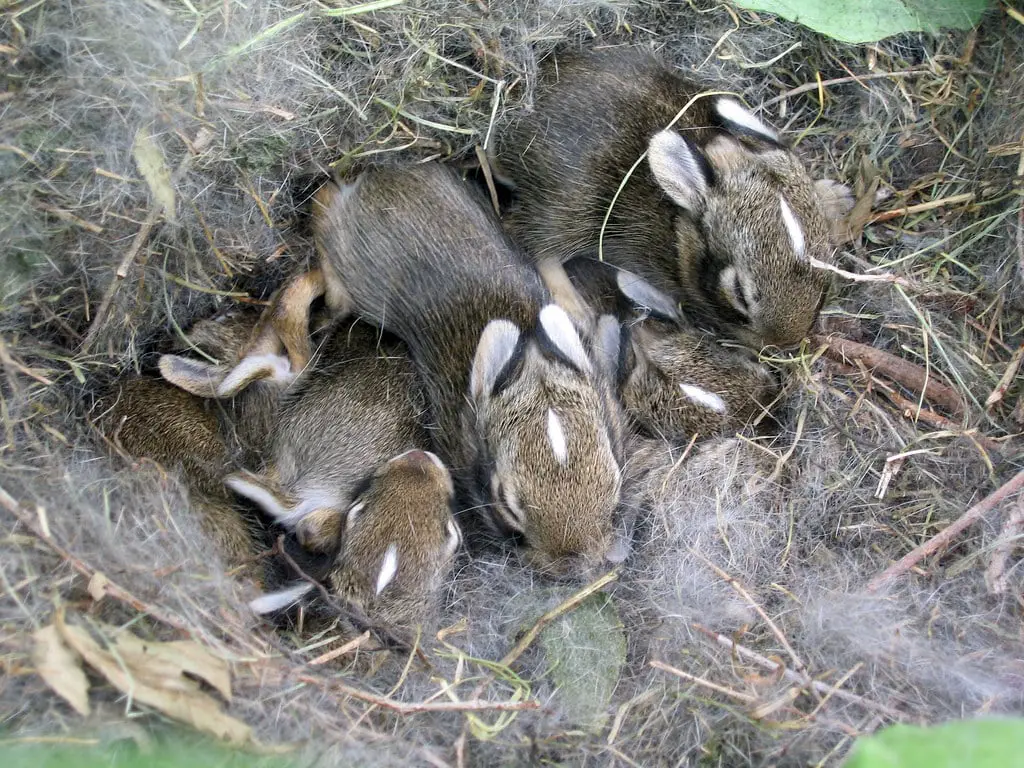
Conclusion
In the intricate tapestry of the natural world, rabbit nests stand as small but enchanting threads, woven with care by the hands of mother rabbits. These unassuming sanctuaries, concealed in the depths of meadows and forests, hold within them the promise of new life and the resilience of the animal kingdom.
The appearance of rabbit nests, characterized by their soft lining of gathered grasses and leaves, their subtle concave shape, and their strategic placement in hidden nooks, reflects the ingenuity of these gentle creatures. Through careful observation and a touch of maternal instinct, rabbits craft cozy havens that cradle their offspring, shielding them from the perils of the wild.
As we unravel the story of rabbit nests, we are reminded of the delicate balance that governs the lives of all creatures. The temporary nature of these nests serves as a reminder of the fleeting moments of vulnerability in the early stages of life, a reminder that survival is a journey that demands resilience and adaptability.
Yet, as we observe from a respectful distance, we gain a glimpse into the wonders of nature’s architecture. We witness the subtle beauty of maternal instincts at play, the artistry of camouflage, and the unwavering commitment of a mother to her young.
Ultimately, rabbit nests inspire us to marvel at the intricacies of the natural world, to embrace the stories that unfold beneath our gaze, and to foster a sense of reverence for the delicate ecosystems that sustain life. In the midst of the bustling world around us, these hidden havens stand as a testament to the quiet miracles that occur daily in the heart of nature, inviting us to pause, observe, and reflect on the extraordinary lives that share our planet.

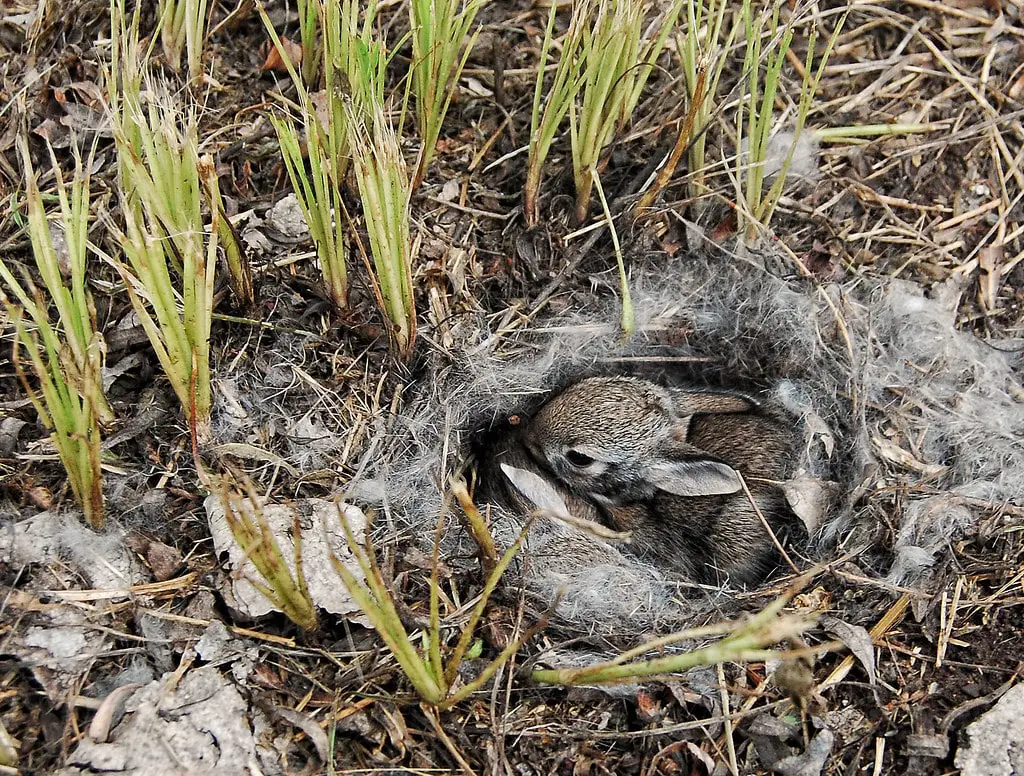
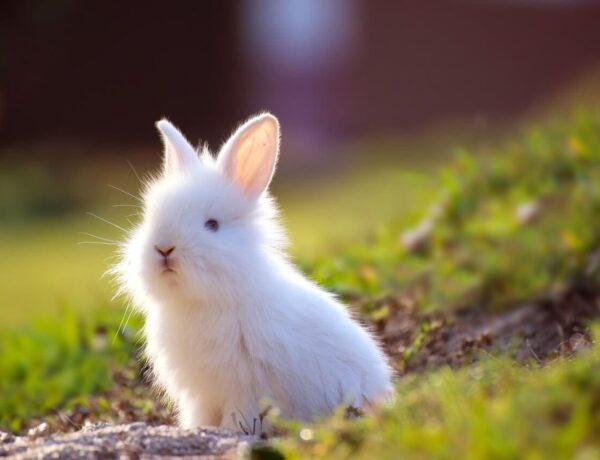
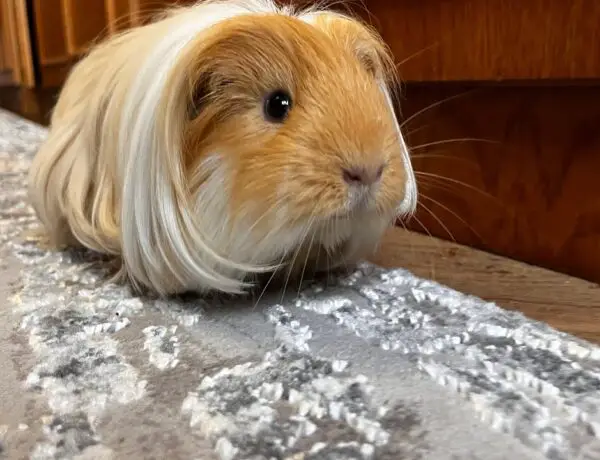
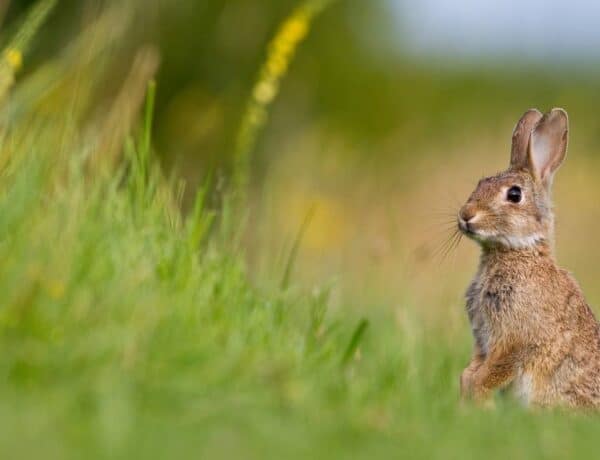
No Comments